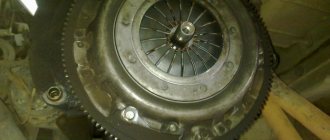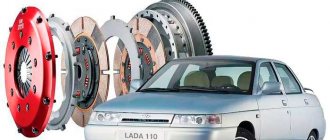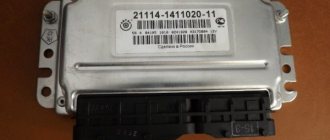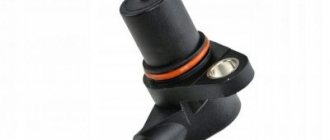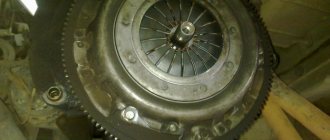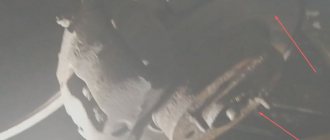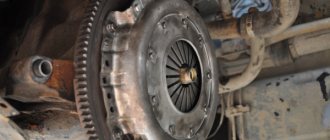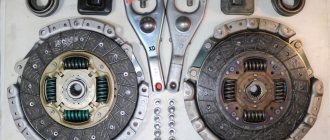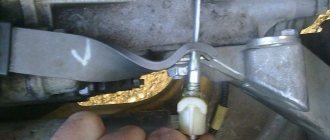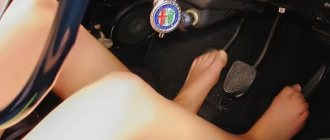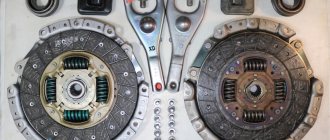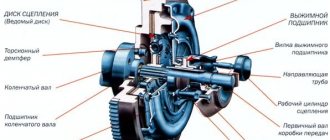Clutch VAZ 2106
On modern cars, the clutch may have a design slightly different from older cars, but the essence of the application of this mechanism remains the same. Like any other vehicle component, the clutch consists of a number of parts that wear out and become unusable over time. Therefore, it is worthwhile to dwell in more detail on identifying the causes and eliminating malfunctions of the VAZ 2106 clutch.
What is the clutch used for?
Equipping a car with a clutch is necessary to separate the gearbox and power plant, their smooth connection at the start of movement, as well as when changing gears. The mechanism is located between the gearbox and the engine, with part of the clutch elements fixed on the engine flywheel, and the other part in the clutch housing.
What does it consist of?
The main structural elements of the node in question are:
- master cylinder;
- working cylinder;
- basket;
- driven disk;
- release bearing;
- fork.
VAZ 2106 clutch device: 1 - adjusting nut; 2 - lock nut; 3 — tension spring; 4 — piston of the clutch working cylinder; 5 - working cylinder; 6 — bleeder fitting; 7 - flywheel; 8 — hydraulic clutch pipeline; 9 - crankshaft; 10 — master cylinder reservoir; 11 — piston of the main cylinder; 12 — pusher piston; 13 - main cylinder; 14 — pusher; 15 — servo spring of the clutch pedal; 16 — clutch pedal release spring; 17 — clutch pedal travel limit screw; 18 — clutch pedal; 19 — pressure disk; 20 — driven disk; 21 — clutch casing; 22 — pressure spring; 23 — clutch release bearing (release bearing) VAZ 2106; 24 — gearbox input shaft; 25 — ball support for clutch release fork; 26 — clutch release fork; 27 — clutch release fork pusher
Master cylinder
The clutch master cylinder (MCC) ensures effective transmission of force from the pedal to the clutch fork through brake fluid and the working cylinder, interacting through the release bearing with the spring elements of the basket. The main circulation pump is located under the hood near the expansion tank and communicates with the working cylinder using a hose. The unit in question consists of a housing, two cylinders with seals and a spring.
The hydraulic clutch transmits force from the clutch pedal to the fork through the brake fluid and the working cylinder
Working cylinder
The function of the clutch slave cylinder (CLC), although simple, is important - to receive the force transmitted from the master cylinder for subsequent movement of the clutch release fork. On the VAZ 2106 the RCS is installed on the clutch housing. Structurally, it is similar to the working cylinder, but has one piston.
The clutch slave cylinder receives force from the main clutch for subsequent movement of the fork
Basket
By means of a pressure disk (basket), the interaction of the driven disk with the flywheel is ensured. If problems occur with the shopping cart, the system stops working. The pressure plate (PD) is pressed against the driven one by means of special springs, which, at the moment the clutch is disengaged, act as return springs, i.e., they press out the PD. This method of operation ensures smooth gear shifting, which increases the service life of gearbox elements.
The basket is made of a diaphragm spring, a pressure disk and a casing. The spring presses on the LP and creates a compression force, transmitting rotation. The spring structure with its outer part acts on the edges of the pressure plate. The inner diameter of the spring is made in the form of petals, onto which the release bearing presses.
Through the basket, the driven disk interacts with the engine flywheel
Driven disk
The driven disk provides a soft connection of the box to the motor. It is located between the basket and the flywheel of the power plant. To ensure that the clutch engages without jerking, the disc design includes springs that help dampen vibrations. Both sides of the disc are equipped with linings made of friction material that can withstand high temperatures.
The driven disk allows for a soft connection of the gearbox to the power unit
Release
The purpose of the release bearing is to separate the basket from the driven disk by pressing the LP petals. The bearing is installed in the clutch housing and moves through the clutch fork.
The release bearing acts on the petals of the basket to separate it from the driven disk
Also check out
- Replacing power steering fluid in a VAZ 2115 without going to a service station
- Algorithm for replacing the front brake pads of Lada Kalina at home
- How to make heated seats on a VAZ 2110 without going to a service station
- Move the gearbox away from the engine as much as possible (the shift lever should rest against the rear cavity of the bottom hole).
- For insurance, install an additional support under the back of the box.
- While holding the flywheel with a mounting tool, use a 13 key to unscrew the 6 bolts that secure the clutch basket. To provide access to the bolts, you need to constantly turn the crankshaft.
Replacing the VAZ 2106 clutch with your own hands
- Move the clutch basket towards the box. Remove the clutch disc.
Replacing the VAZ 2106 clutch with your own hands
- Move the clutch basket towards the engine and remove it.
Replacing the VAZ 2106 clutch with your own hands
- As soon as you manage to pull the basket out of the clutch housing, remove the clutch fork. The release bearing must be removed from the transmission input shaft.
Replacing the VAZ 2106 clutch with your own hands
Wipe the basket, clutch disc, and flywheel with a clean rag moistened with gasoline. Reinstall the clutch parts in reverse order. Using a special mandrel that imitates the splined element of the transmission input shaft, center the clutch disc in relation to the bearing of the end part of the crankshaft. After tightening the bolts that secure the basket to the flywheel, you need to pull out the mandrel.
Replacing the VAZ 2106 clutch with your own hands
It is worth applying CV joint-4 lubricant to the splines of the first shaft. After completing the clutch replacement, it is necessary to adjust the stroke of the clutch slave cylinder rod (this element must be free).
Clutch problems
The VAZ 2106 clutch, although rare, still causes problems for the owners of this car. Malfunctions can be of various types and they also manifest themselves in different ways. Let's take a closer look at them.
Brake fluid leak
The working medium of the “six” clutch mechanism is brake fluid, which sometimes leads to some problems:
- Fluid leakage due to damage to the hose between the master and slave cylinders. The connecting element may become unusable when installing a low-quality product or as a result of rubber aging. To eliminate the problem, the hose will need to be replaced;
Liquid leakage is possible if the hose connecting the GCS and RCS is damaged - depressurization of the main circulation system. The tightness in the cylinder is ensured by lip seals, which wear out and become rough over time, as a result of which they begin to leak liquid. The way out of the situation is to replace the cuffs and then bleed the system.
Drives the clutch
The concept of “clutch drive” is used when the mechanism is not completely disengaged. This can happen for several reasons:
- The driven disk was damaged, causing axial runout. The most correct solution is to replace the part;
- Cracks have formed on the driven disk linings. The appearance of defects is reflected in the inability to engage the clutch in a timely manner. In this case, you should replace the entire disc or the pads themselves;
- The rivets of the friction linings have failed. When the rivets wear out, the fixation of the linings weakens, which leads to problems when the clutch is disengaged and increased wear of the linings themselves;
- Air has entered the hydraulic system. The problem is “treated” by pumping fluid;
- basket distortion. Although the malfunction is rare, if it occurs, you will have to purchase a new pressure plate.
The clutch is slipping
When clutch slip occurs, the mechanism does not engage completely, but this happens for the following reasons:
- oil got on the friction elements of the driven disk. You will have to remove the gearbox and disassemble the clutch mechanism to clean the linings with white spirit;
- The compensation hole in the main circulation system is clogged. To fix the problem, you will need to remove the cylinder, remove the blockage, and then rinse the product in kerosene;
- Friction linings are burnt. The malfunction is eliminated by replacing the driven disk.
Oil getting on the driven disc can cause the clutch to slip and operate jerkily.
Clutch pedal squeaks
The pedal may squeak due to lack of lubrication in the bushings or when the bushings themselves are worn out. To fix the problem, the pedal will need to be removed, the bushings checked for wear, replaced if necessary, and lubricated.
If the clutch pedal bushings are worn or lack lubrication, the pedal may squeak.
Noise when depressing the clutch pedal
On a VAZ 2106, noise when releasing the clutch pedal may appear for the following reasons:
- bearing failure on the gearbox input shaft. The problem appears in the form of a characteristic cracking sound when the clutch pedal is released. In this case, the bearing will have to be replaced;
- release bearing wear. The part fails due to lack of lubricant, which is squeezed out over time. To eliminate the malfunction, the bearing must be replaced.
Noise when pressing the clutch pedal
The clutch may also make noise when you press the pedal. The reasons may be as follows:
- loss of rigidity or breakage of the springs of the driven disk. This leads to vibrations that cannot be extinguished in a timely manner. The solution to the problem is to replace the driven disk;
A broken spring in the driven disc may cause noise when the clutch pedal is pressed. - Damage to the release bearing or basket.
If, when noise occurs, the problem is not resolved within a short time, then the broken part may damage other elements of the mechanism.
The pedal falls
There are cases when on a VAZ “six”, after pressing the clutch pedal, it does not return to its initial position. There are few reasons for this phenomenon:
- air entering the hydraulic drive system. In this case, the pedal “falls” after several presses, so the system will have to be pumped;
- the spring responsible for the pedal return fell asleep. It is necessary to check the spring and, if necessary, replace it.
Video: clutch problems and solutions
Clutch installation
After repairing or replacing the clutch, installation is carried out as follows:
- We lightly lubricate the gearbox input shaft, as well as the ball joint of the fork, with CV joint-4.
